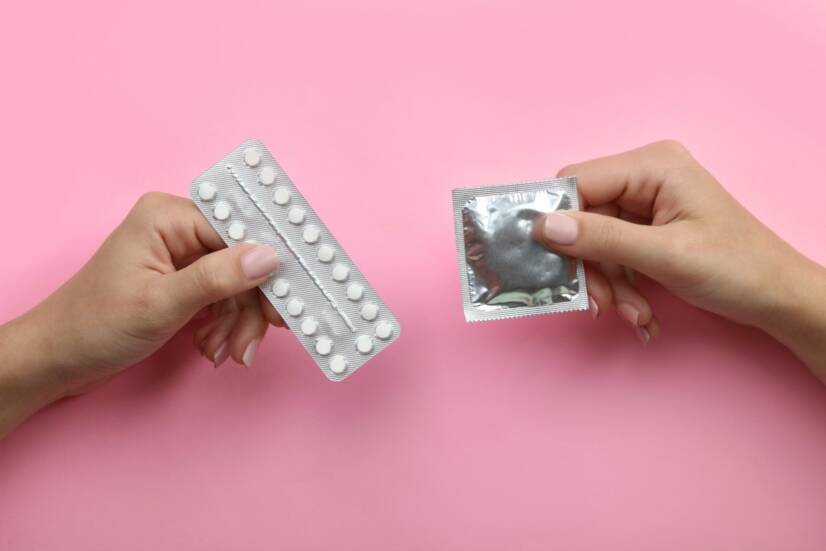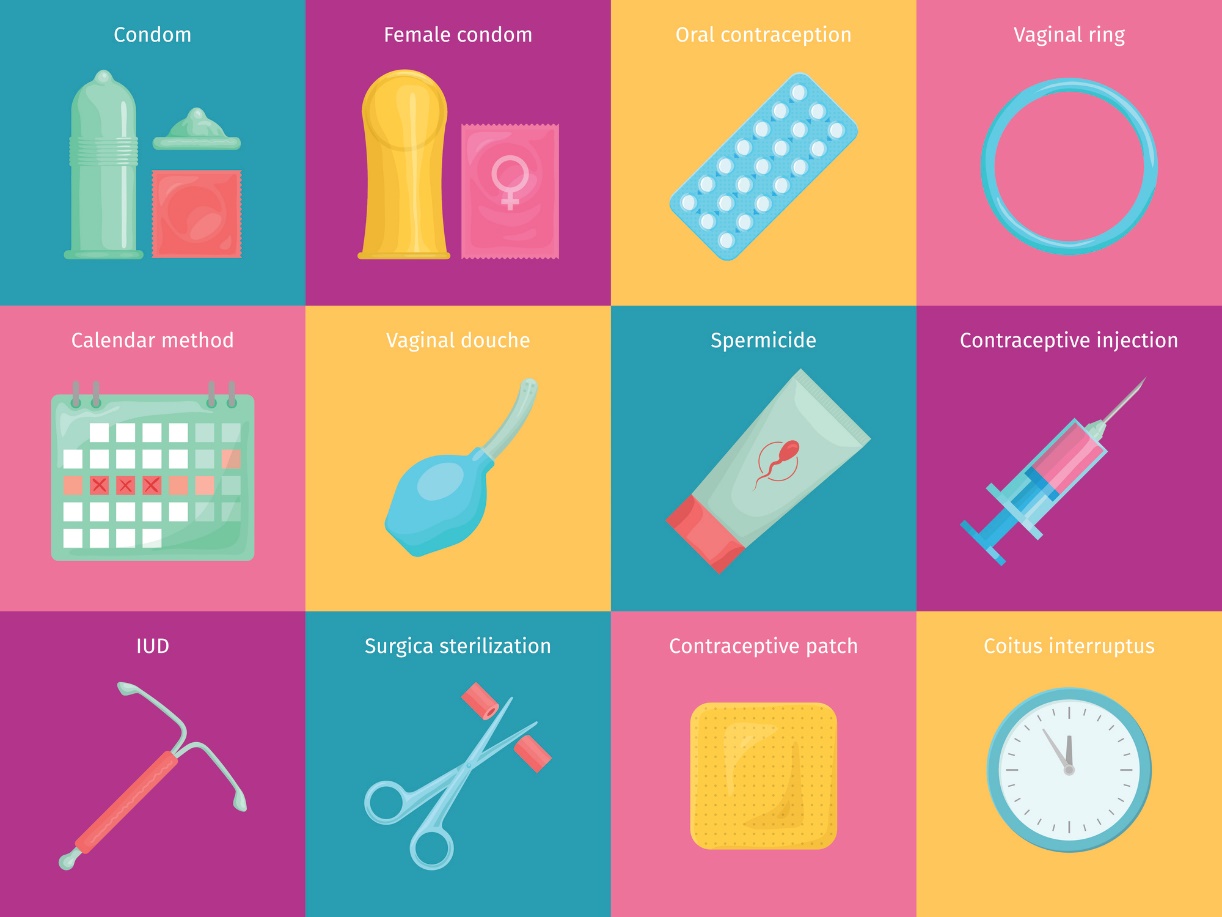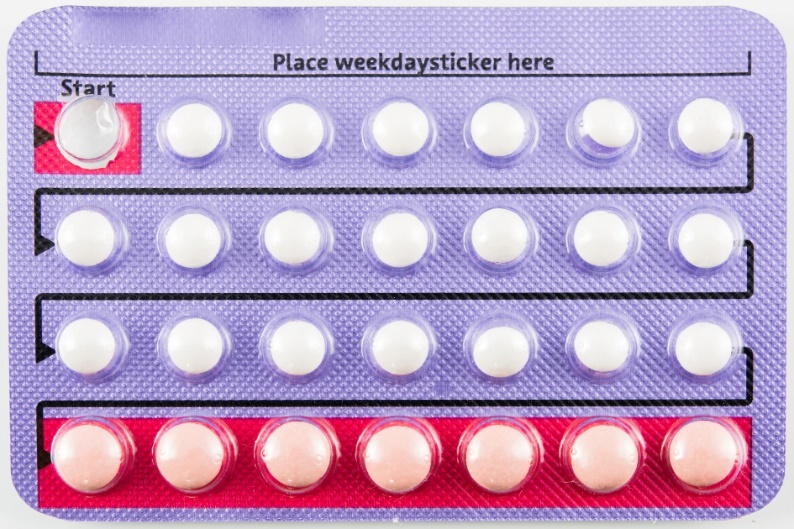- solen.sk - Contemporary view on forms and options of contraception. Michal Kliment, M.D. , Vladimír Cupaník, M.D.
- solen.sk - Contemporary contraception in adolescent girls. MUDr. Rastislav Sysák, PhD.
- ROZTOČIL, Aleš and Pavel BARTOŠ. Moderní gynekologie. Prague: Grada, 2011. ISBN 978-80-247-2832-2
- solen.sk - Hormonal contraception. Solen. Igor Lazar
- ROB, Lukáš, Alois MARTAN and Pavel VENTRUBA. Gynecology. Third, supplemented and revised edition. Prague: Galén, [2019]. ISBN 978-80-7492-426-2
Contraception and young women: what are its benefits and risks? + Types

Contraception refers to a group of methods by which unwanted pregnancy can be prevented. Many forms of contraceptive use or application are currently available. What are their benefits and, conversely, their health risks?
Article content
- Contraception and young women (girls)
- Types of contraception
- Contraceptive pills
- Health risks and benefits of taking hormonal contraceptives
- Intrauterine Device (IUD)
- Subcutaneous implant
- Contraceptive patch
- Vaginal ring
- Contraceptive injections
- Emergency contraception - "the pill after"
- Female sterilization
- Does hormonal contraception affect body weight?
Contraception must meet certain requirements of harmlessness, ease of application and, last but not least, reliability.
Today, there are natural methods of preventing conception, barrier and chemical methods, sterilisation and, last but not least, hormonal contraception in various forms.
Contraception and young women (girls)
In recent years, there has been an increase in the use of contraception, especially hormonal contraception, among young women and girls.
Boththe age of menarche (first menstruation) and the age of kotarche (first sexual intercourse) are currently decreasing. For this reason, the demand for and use of contraception among young women - adolescents - is also increasing.
In the case of female minors, a paediatric gynaecologist should prescribe hormonal contraceptives to persons under the age of 18 only with the consent of their parents or legal guardians.
However, according to the European Union, it is possible to prescribe certain contraceptive measures to a minor without parental consent.
The age of the patient, the presence of menstrual cycle pathologies and the frequency of sexual intercourse must be taken into account when considering the appropriateness of contraception.

Types of contraception
Non-hormonal contraceptives
Non-hormonal forms of contraception include natural, chemical and barrier (mechanical) methods.
Natural methods are based on knowledge of the physiology of the menstrual cycle and the counting of a woman's fertile and infertile days. They are based on the length of the cycle, the date of ovulation, the fertile window, and the temporal ability of the sperm to fertilise the egg cell.
- How does fertilization of the egg occur and how long does it take to nest?
- Ovulation, calculation of fertile and infertile days. How to plan pregnancy?
- Pregnancy calculator and calculation.
Natural methods also involve examining your own body - the presence of cervical mucus from the vagina on fertile days and measuring basal body temperature. Basic natural methods include intermittent coitus (pulling out the male sex organ before ejaculation).
The disadvantages and risks are inadequate protection against sexually transmitted diseases and a low degree of protection against unwanted conception.
Barrier methods mechanically prevent the male sperm from accessing the female sex cell - the egg. This includes primarily the condom, while the use of a pessary or vaginal sponge is not as widespread on the market.
The undeniable advantage of the condom is the high degree of protection against sexually transmitted diseases.
A pessary is a silicone, non-harmful, flexible cup that is inserted into the woman's vagina before sexual intercourse. Its purpose is to create a barrier towards the cervix, thereby preventing sperm from penetrating further into the uterus.
Chemical methods consist of substances in the form of special foam, cream (gel) or vaginal suppositories. Spermicidal gel reduces the mobility of sperm and is applied before intercourse.
The pH value of the spermicidal gel is acidic, creating an unfavourable environment for the male sperm inside the vagina.
Chemical methods are recommended to be used in combination with barrier methods as they do not protect against the transmission of STIs.
The advantage of barrier or chemical methods is the absence of hormones. However, the disadvantage is the possible presence of local irritation of the vaginal mucosa of the woman.
Hormonal contraception
Hormonal protection against unwanted conception affects the levels of female hormones in the body.
Hormonal action is based on artificially synthesised hormones, which are injected into the body in various forms - orally (pills), by injection, vaginally, or through subcutaneous implants or special patches.
The hormones released into the body stop ovulation - the release of an egg from the female sex cells from the ovary.
They also thicken the cervical mucus to make it harder for sperm to pass through, affect the peristalsis of the fallopian tubes and also thin the lining of the uterine lining. This creates unfavourable conditions for fertilisation and for the egg to settle in the uterus.
The forms of hormonal contraceptive application include:
- Oral tablets
- Intrauterine device
- Vaginal ring
- Skin patch
- Subcutaneous implant
- Injection
Principle of action of hormonal contraception
The basic effect of hormonal contraception is to block ovulation by negatively binding the neuroendocrine hypothalamo-pituitary system and blocking the nucleus arcuatus in the brain in the hypothalamus (the site of gonadotropic hormone - GnRH - release).
Thus, the mechanisms of action include inhibition (reduction) of GnRH secretion, reduction of pituitary sensitivity to GnRH, and subsequently reduction of follicle stimulating hormone (FSH) secretion itself and blockade of luteinizing hormone (LH) rise during a woman's menstrual cycle.
The consequence of these hormonal changes during a woman's cycle is anovulation - a woman's cycle without the presence of ovulation.
Depending on the content of specific hormones, hormonal contraceptives are divided into combined (containing the hormone gestagen and estrogen) and single gestagen contraceptives.
1. Combined oral contraceptives (COC) are composed of two hormonal components - estrogen and gestagen.
The basic mechanism of action of combined hormonal contraceptives is blocking ovulation, thickening of cervical mucus and inhospitable changes in the uterine mucosa.
In the development of contraception towards lower hormonal doses, monitoring of efficacy and analysis of results have shown that the contraceptive effect depends not only on the dose of hormones, but primarily on the accuracy and regularity of their use.
The advantages of combined hormonal preparations are high contraceptive reliability, ease of oral administration and easy availability.
Dysmenorrhoea (excessively painful menstruation and PMS) is one of the most common health problems for which women are interested in hormonal contraceptives. It is reported that approximately 80% of women taking a combined form of hormonal contraception experience an improvement in their problems.
2. Gestagen hormonal contraceptives are products containing only gestagen. This type of contraceptive can be taken orally, injected, vaginally and with subcutaneous implants.
The most commonly reported side effect is irregular bleeding. However, it also has a good therapeutic effect on dysmenorrhoea (excessively painful menstruation), endometriosis or endometrial hyperplasia.
Gestational contraception is a suitable choice for women with contraindications to estrogen use.
These are mainly women with poor tolerance to combined contraceptives, women at risk of thromboembolism, cancer of the uterine lining or women with various liver diseases.
Possible contraindications to this form of contraception include coronary heart disease, ovarian cysts, certain menstrual cycle disorders, epilepsy and others.
The choice of a particular form and type of contraception depends on the age and health of the woman, the examination and the discretion of the gynecologist.
Contraceptive pills
Birth control pills first appeared on the market approximately forty years ago. To date, they are the most widely used form of hormonal contraception.
The pharmaceutical industry has tried, and continues to try, to create contraceptives with the maximum level of effectiveness and at the same time with the minimum number of side effects.
However, contraceptive pills do not protect against sexually transmitted diseases, which is why the simultaneous use of mechanical protection, i.e. a condom, is recommended.
The hormones in the contraceptive pill may cause unwanted side effects in some women, but these usually subside within 2-3 months.
However, if a woman experiences non-specific or strong side effects, or if they last for a longer period of time, her gynaecologist should be contacted.
Possible negative side effects:
- Headache
- nausea
- feeling like vomiting
- tenderness of tender breasts
- watering of the body
- spotting (light bleeding outside the cycle)
- decreased libido (sexual desire)

Health risks and benefits of taking hormonal contraceptives
A serious risk of taking birth control pills (especially combined pills) is the risk of developing a blood clot. Subsequently, there is a risk of thrombosis, pulmonary embolism, heart attack or stroke.
The high-dose estrogen component of contraceptives can increase the incidence of cardiovascular disease. The hormone estrogen increases the synthesis of clotting factors in an individual's blood.
The risk of thromboembolism in women without combined hormonal contraception is approximately 1 : 10 thousand women per year. In COC users it is approximately 2-3 : 10 thousand women per year.
According to the WHO, the risk of thrombosis in COC users with a thrombophilic mutation is approximately 22 times higher than in women with physiological blood clotting parameters.
The incidence of adverse effects is also directly related to the hormone content. The development of medicine and pharmacy is therefore directed towards a gradual reduction of the hormone doses in contraceptives.
Absolute contraindications to combined hormonal contraception:
- Breastfeeding women up to 6 months after childbirth
- Smoking more than 15 cigarettes per day in women over 35 years of age
- Hypertension (high blood pressure)
- Deep vein thrombosis
- Presence of thrombophilic mutations
- Diabetes mellitus with vascular or renal complications
- Breast cancer
- Liver disease
Therefore, information about the diagnoses and diseases that the patient has and that are present in her family history is very important for the gynecologist.
Risk groups for prescribing hormonal contraception include cardiovascular disease, thrombosis, cancer, diabetes mellitus, high blood pressure and cholesterol, liver and kidney disease.
It is important for a woman to be honest about the amount of smoking, alcohol consumption, drug use, medications and the presence of allergies.
However, hormonal contraception is also known for its various benefits:
- timing of the menstrual cycle
- weakening and shortening the length of menstruation
- relieving pain during menstruation
- eliminating PMS (premenstrual syndrome)
- improving acne and rashes
- treatment of polycystic ovaries
- alleviation of migraines and headaches
Intrauterine Device (IUD)
A special anchor-like (or T-shaped) body that follows the shape of the uterus is inserted into the woman's uterine cavity.
The hormone acts primarily locally and the substance enters the bloodstream in smaller quantities than, for example, with oral hormonal contraceptives.
Unlike other methods of contraception, IUDs do not require daily use or application before sexual intercourse.
A non-hormonal variant is the IUD, which is composed of copper and based on the principle of spermicidality.
The IUD is beneficial for painful excessive menstruation and severe premenstrual syndrome. Contraindications to IUD use include various uterine diseases, unexplained local bleeding or congenital malformations of the uterus.
Subcutaneous implant
A special implant is inserted by a simple surgical procedure into the patient's subcutaneous tissue (most often in the area of the non-dominant arm). The hormone gestagen contained in the implant is gradually released into the bloodstream and exerts a contraceptive effect.
Currently, there are several different types of implants containing different forms of gestagens. The contraceptive effect is achieved mainly by inhibiting ovulation, with a duration of effectiveness of 3 years per implant.
As with other forms of hormonal contraception, side effects may occur initially (headache, breast tenderness, etc.), but should soon subside. If any symptoms and pain are unclear, professional help should be sought from a gynaecologist.
Contraceptive patch
The functionality is based on the content of the hormones estrogen and gestagen in the patch. The patch must be applied regularly once a week and the fourth week is subsequently without application.
It is important to read the package leaflet and the manufacturer's instructions. The patch should not be applied to the breast area. The patch should be applied to an intact, clean, degreased and non-peeling area of skin.
The contraceptive patch releases the necessary amount of hormones through the skin daily, which enter the bloodstream and prevent unwanted pregnancy (and possible miscarriage).
- The first signs of pregnancy. When do they start and how do you recognise them?
- No, false, possible or certain first signs of pregnancy. When do they appear?
- Miscarriage: what are the types and stages of miscarriage? What does miscarriage involve?
Vaginal ring
The vaginal contraceptive ring is inserted once a month into the vagina and remains in the vagina for 21 days. It is soft, flexible and adaptable. The advantage of this form of protection is the lower hormone levels and its local action.
In some cases, it takes women longer to get used to the vaginal ring. Slight side effects may occur (as with other forms of hormonal contraception), but these should subside within 2-3 months.
The disadvantage of the patch, implant, pill and ring is the lack of protection against the risk of sexually transmitted infections.
Contraceptive injections
The injection is given into a muscle (arm or buttock area). It prevents unwanted pregnancy by releasing the hormone progesterone into the woman's bloodstream. It prevents the release of eggs, ovulation and thickens cervical mucus.
The injection is administered by a doctor or nurse in a gynaecological outpatient clinic. Its effectiveness lasts for 8-12 weeks. However, a full return of fertility may take up to 1 year after the injection is stopped.
Emergency contraception - "the pill after"
Emergency contraception is taken orally in pill form shortly after unprotected intercourse - in acute cases where other forms of conventional contraception have failed (broken condom, unused contraceptive pill, unused patch, etc.).
It should be used as soon as possible after unprotected intercourse, but no later than 72 hours. The later the pill is taken 'after', the more its effectiveness is reduced. It is therefore necessary to read the package leaflet and the manufacturer's instructions.
However, the "after" pill must not be taken frequently and regularly, as it is an acute form and content of hormonal contraception.
The pill "after": what are its effects, reliability and health risks?
Female sterilization
Female sterilisation (also referred to as tubal ligation) is a permanent contraceptive method for women who no longer wish to have children in the future.
However, female sterilisation does not prevent sexual intercourse.
Does hormonal contraception affect body weight?
Studies analysing weight changes in women taking combined hormonal contraceptives report an average weight gain of about 0.5 to 1 kg for medium-dose and up to 0.5 kg for low-dose products.
Combined hormonal contraceptives can bind salts in the body, to which water subsequently binds - and this can cause a slight accumulation of water in the body's subcutaneous tissue.
Hormonal preparations can also positively affect appetite, so some women may experience a slight increase in weight.
Nowadays, it is advisable, with the help of a gynaecologist, to choose low-dose hormonal contraceptives, whose effect on metabolism is much less than it was in the past.
The important thing is honesty, trust, a thorough gynaecological examination and finding a suitable form of contraception together with the doctor.
Interesting resources
Related










